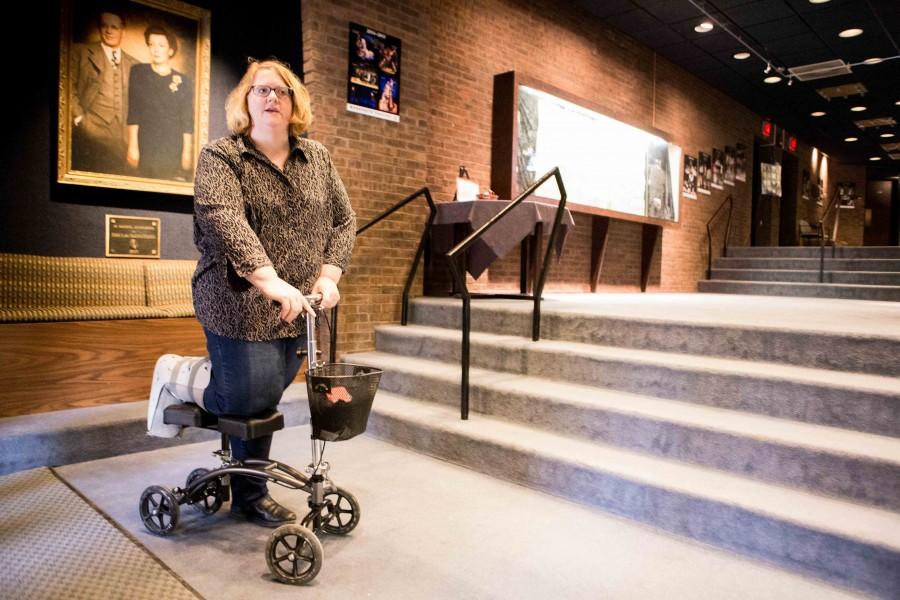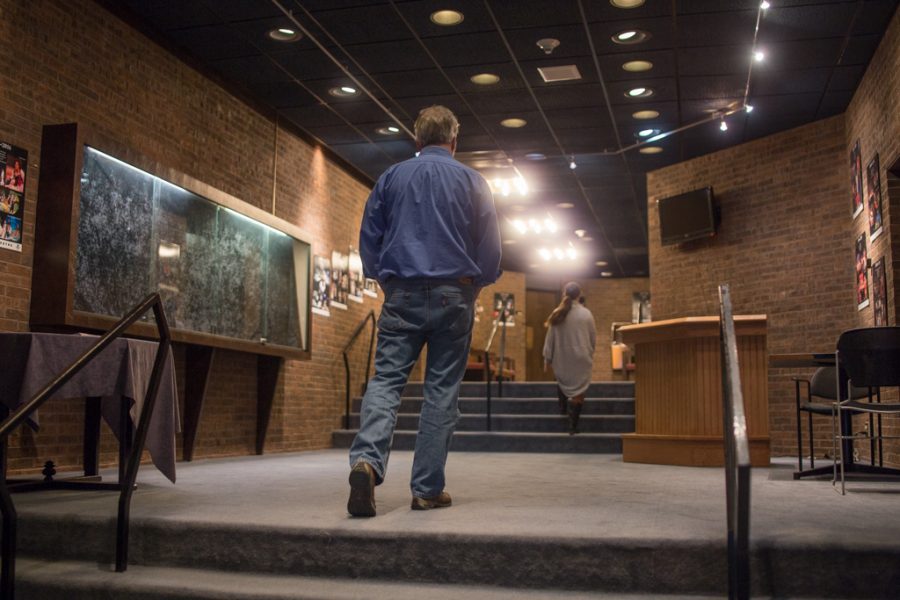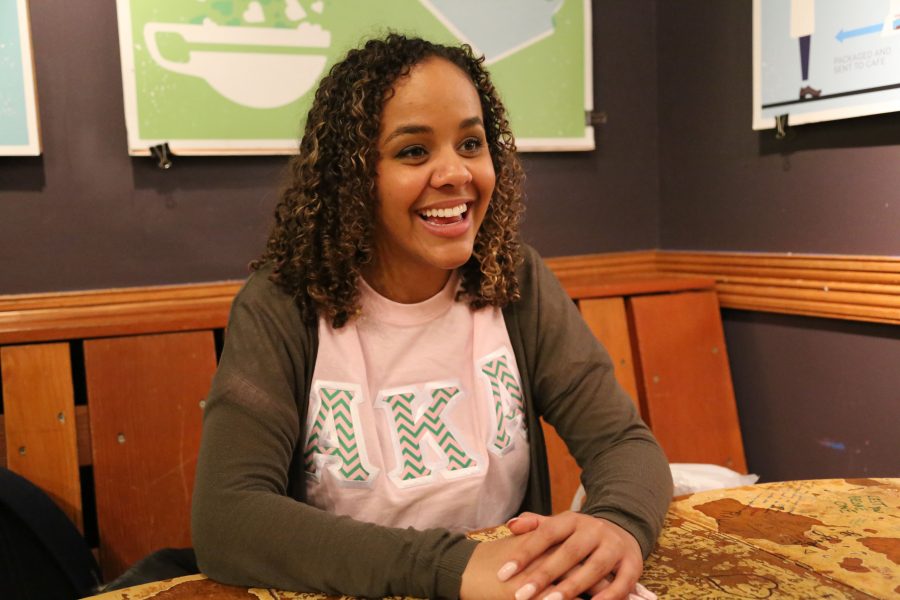Brielle Richmond, a freshman in the College of Communication, did not have the option to start her freshman year on solid footing.
Last semester, the theatre arts major managed to get through orientation week – on crutches, and with much difficulty.
Richmond, like many other students, faculty members and patrons of Helfaer Theatre, found herself in a battle to maneuver around the building which houses her major. Helfaer can be difficult to navigate for those not able-bodied.
“It’s embarrassing,” said Connie Petersen, an assistant professor of theatre arts who was on a knee scooter most of the fall 2015 semester. “It’s embarrassing for patrons who come who are not part of Marquette, and how shocked they are (at) how much work it takes to get to somewhere (in this building).”
Several of Marquette’s aging facilities pose accessibility challenges, despite every building on campus technically being in compliance with the Americans with Disability Act’s requirements. For example, the Marquette gym does not have an elevator, and in the counseling center, located in Holthusen Hall, a few steps prevent people from getting into the waiting room. These buildings are less accessible, leaving students, faculty and visitors to wrestle with the simple question: How do we get around?
For Richmond, the answer eventually became clear: Don’t even try.
“It made me not want to go to class,” she said.
Early in the semester, her grades suffered. She skipped classes to avoid dealing with the struggle of getting to class in addition to her pain, she said. Many other days, she was late because it took too long to get around. Simply going down one floor required going outside and following the sidewalk in a large circle in front of the theater and up a paved ramp on the side of the building.
https://www.youtube.com/watch?v=9nF3nP3-XfY
“Everything takes longer”
Petersen has worked at Marquette for 14 years.
In addition to her theatre arts assistant professorship, she serves as the manager and leader of the costume shop. Students see her as an integral member of the theatre and the performing arts program.
“With Connie, it’s kind of sad because it’s like the theater is basically her home, and when she can’t have comfort in her home, it’s just frustrating,” said Chloe Hurckes, a sophomore theatre arts major in the College of Communication. “It’s a lot of work … to travel any distance. So a lot of times she’d be huffing and puffing from (her travel). She could have just easily rolled down the hall if we had another bathroom.”
Petersen was in an immobilizing boot following knee surgery over winter break. The doctors said she would need to wear it for eight to 12 weeks, during which time she relied on a knee scooter to get around campus. In a building with no elevator, her access to the Xerox machine, other faculty offices and even the only bathrooms in the building proved excessively difficult.
“Everything takes longer,” Petersen said.
She rolled up and down the inclined sidewalks outside Helfaer each day to access the resources, carefully monitoring her speed so she wouldn’t fall over and cutting through other buildings to get around as quickly as possible. To help accommodate her, one of her classes was moved to Lalumiere Hall. She said she relied heavily on help from her students.
“It’s easy when I have students to help me, but I have to know when the students are coming in,” Petersen said. “It’s like, ‘OK, I’m going to have to wait until 1 o’clock when this student comes in to help me get something upstairs.”
After Richmond was off of her own crutches, she said she made a point to help Petersen as much as possible. She said her experience gave her a new appreciation for her body.
“You never know how much you need an arm or a leg until you can’t use it anymore,” Richmond said. “With Connie … I knew it took a toll on her body. To see her travel back and forth using that same route – I know that’s tiring.”
Richmond recalled the added difficulty of being a professor and said that sometimes Petersen’s classes would start late because of the long travel time.
“There needs to be something (done),” Richmond said.
This is not Petersen’s first time navigating the theater with limited mobility. Eight years prior, she had a similar surgery. She said more attention is being paid to her situation this time around than in the past. College of Communication interim dean Ana Garner and two university architects walked through the building with her in January to better understand the issue.
“(The architects) were both shocked,” Petersen recalled. “Like, ‘Whoever designed this building did not think things through.’”
https://www.youtube.com/watch?v=6JfcRdPhGUg
Following the guidelines
Still, Helfaer is technically compliant with ADA regulations. However, they aren’t up to date with the current codes because it was effectively grandfathered in since it was built in 1977 – before the ADA was implemented.
Created in 1990, the ADA promotes greater equality for people with disabilities in employment, state and local government services, public accommodations, commercial facilities, and transportation.
One component of this effort is the guidelines for how a building should be constructed or renovated to meet accessibility standards. These regulations were created in 1991 and then updated in 2010. Yet, the law is flexible in what it requires of institutions. Specification of what renovations are required is outlined in Title III of the law. Alterations to a building requires the institution to ensure the area is accessible “to the maximum extent feasible,” if it is unable to comply fully with the law.
“It’s always an ongoing burden to continue to improve, but the ADA doesn’t require places to be in full compliance from the get go,” said Tim Ochnikowski, Milwaukee County’s ADA coordinator. “It was written purposefully not to do that, not to create problems with state and local governments who have very large and very old buildings.”
When updating campus buildings, it comes down to priorities, said Stephen Hudson-Mairet, the chair of Marquette’s digital media and performing arts department.
“It’s an ongoing issue within the greater university,” Hudson-Mairet said. “There are always facility needs and from a university standpoint, they need to take a look and see what the priorities are. … Clearly, the university is aware of the issue.”
The law’s flexibility and exemptions allow institutions to prioritize where they place their resources and determine what modifications are feasible. They also do not require constant updates of facilities.
Ochnikowski said universities usually maintain accessible facilities voluntarily, as it helps attract students.
“All facilities on our campus are compliant with the ADA standards that were in place at the time of the building’s construction,” said chief university planner and architect, Lora Strigens, in an email. “As we engage in major renovation projects to existing buildings, it is our best practice and a requirement that we bring those facilities up to current ADA guidelines.”
A shift in attention
Regardless, no one is ever turned away from Helfaer Theatre.
Rather, students and faculty go out of their way to accommodate guests as they can. The house manager for each show is given training on how they can help the theater’s (often older) patrons get to their seats with as much ease as possible. Yet, some say that the structural issues are a source of embarrassment for everyone involved, bringing attention to a person’s disability.
“None of us would ever complain about having to do more work to get anyone (into the theater), but also when we’re pulled away to help someone navigate something that should be so easy to navigate, it takes us away from the other problems,” Hurckes said. “We don’t want to give people special attention just because they have a disability or a handicap, but it’s like we’re kind of forced to do that because we know they’re not going to be able to get through easily.”
Hurckes, who served as house manager for the theater’s production of “To Kill a Mockingbird,” worked with what she says are many embarrassed and upset patrons in her time at the theater and said she even felt embarrassed herself. She recalled patrons who told her the paved ramp that serves as an entry was too steep, angled and bumpy for a person to ride up. It took a woman 10 minutes to walk up the steep steps in the lobby with others helping. She said many people just stay in their seats during intermissions. Some patrons even enter the theater from behind the stage.
The ease with which people with disabilities should be able to get around hits close to home for Hurckes. Her uncle has multiple sclerosis. While he loves seeing his niece perform (he attended every one of her plays in high school), he will likely never see her on Helfaer’s stage.
“It’s sad, because it’s pretty much just me saying, ‘Don’t even bother,’ (even though) it’s something that makes him happy,” Hurckes said. “I’m sure there are many other people who have family members or friends who can’t really come either.”
The issue of limited access to certain resources or experiences also arises in the counseling center, which is not handicap-accessible, said the center’s director Michael Zebrowski.
“The counseling center staff is very disappointed that this ADA issue cannot easily be resolved,” Zebrowski said in an email. “We are dedicated to the ideal of universal design and treating all clients equally.”
Students who are unable to get up the stairs outside the center’s waiting room are brought in from a side entrance and are seen in a more accessible room. Zebrowski said the university architect reviewed the space and suggested renovations, “but the cost was prohibitive, and the solution proposed was not acceptable.” He said the center will likely have to be relocated in the future.
If any renovations were made to Helfaer or anywhere else on campus, the ADA would require the area to be brought up to date with 2010 accessibility requirements to the best of the university’s ability. Certain exemptions exist, including one that says a building less than three stories high or less than 3,000 square feet per story does not require an elevator, as is the case with the theater.
Hudson-Mairet said that in his 16 years working at Marquette, the only modification he has seen in the theater was the re-upholstering of the seats in 2000 – an update too minor to require an accessibility update by law.
He and Petersen said that while renovations are certainly needed, the biggest challenge is cost and university priorities. In line with the university master plan’s recommendations, the Department of Facilities Planning & Management will commission a review of the theater’s facilities that will result in a cost estimate and a plan to improve conditions as much as possible, Strigens said in an email.
A major renovation project of the historic core, elevator accessibility work in two residence halls, and bathroom accessibility work in five buildings on campus have made improvements in many areas of campus that serve a large number of people, including the Alumni Memorial Union and Schroeder Hall, Strigens said.
“Facilities Planning & Management is constantly looking for ways to increase accessibility,” she said. “Any opportunity is considered against other issues needing correction with the goal of making the most impact with the limited resources we manage.”
Even with limited resources and priorities taken into account, many maintain that the time to invest in Helfaer, which will be half a century old next year, has come.
“I don’t buy it,” Richmond said. “I feel like as a part of the campus, each building should get the same amount of treatment. Looking at Johnston and all these other buildings in comparison to Helfaer, you see the difference. Helfaer is an old building that has little to no renovations. … I think as a theater, (people) already say that the major isn’t really considered a lot. I think (this) is just another way of showing that we matter, but not as much as (the others).”
—Brittany Carloni, general assignment news reporter, contributed to this article.
Story was updated at 2:36 p.m. on Friday, April 15th. An earlier version of this article incorrectly stated Connie Petersen had been in crutches most of last semester. In fact, she had been in a knee scooter, not crutches. The Wire regrets the error.







Debra Krajec • Apr 14, 2016 at 5:57 pm
Thank you for this article. Helfaer is one of only two venues on campus that are regularly presenting events to the Milwaukee public. Marquette will hopefully raise the priority of these needed improvements very soon. We need to care for all students, employees and guests, able and differently abled.
I would also like to point out the lack of a way to drive close to Helfaer Theatre building, to drop off patrons who may not be able to walk a far ways. Right now there is no way to drive close to the entrance if the building. This is especially problematic in the snow and ice.
Parking is also an issue. With the loss of M lot under the freeway over 10 years ago, the major place for patrons to park was lost and then the loss of the small Haggerty Museum lot when the Law school was built can make it quite hard for off campus folks attending Helfaer events to find parking within several blocks.
Again, thank you for this article, and for raising the issue of accessibility on our campus.